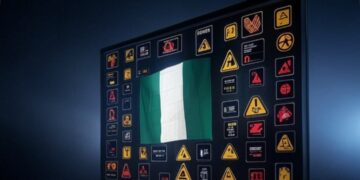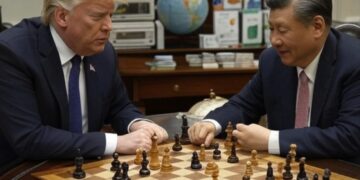To some, he was a revolutionary hero, a champion of Pan-Africanism who defied Western imperialism. To others, he was a ruthless dictator whose regime sponsored terrorism and suppressed dissent. Yet, in the twilight of his rule, Gaddafi issued stark warnings about the consequences of his ouster—prophecies that have proven eerily prescient. He cautioned that his fall would unleash chaos, allowing terrorists to seize Libya’s vast resources and destabilize the region. The United States, leading a NATO coalition in 2011, dismissed these warnings, prioritizing regime change over stability. This article examines America’s role in dismantling Gaddafi’s government, critiques the intervention’s shortsightedness, and reflects on how Libya’s current reality—marked by militia rule, terrorism, and fragmentation—vindicates Gaddafi’s foresight.
The Context of Intervention: A Misguided Mission
In early 2011, the Arab Spring swept across North Africa, igniting protests in Libya against Gaddafi’s 42-year rule. Initially peaceful, the demonstrations escalated into an armed rebellion, fueled by decades of grievances over political repression and economic inequality. Gaddafi’s response was brutal, with his forces launching indiscriminate attacks on protesters and rebels, particularly in Benghazi. The United Nations Security Council, alarmed by reports of civilian casualties, passed Resolution 1973 on March 17, 2011, authorizing a no-fly zone and “all necessary measures” to protect civilians, short of foreign occupation.
The United States, under President Barack Obama, seized this mandate as a green light for intervention. On March 19, a NATO-led coalition with significant U.S. involvement launched Operation Unified Protector. American and British forces fired over 110 Tomahawk cruise missiles, while French, British, and Canadian air forces conducted sorties to cripple Gaddafi’s military. The stated goal was humanitarian: to prevent a massacre in Benghazi. However, the mission swiftly morphed into regime change, a shift that exceeded the UN’s mandate and ignored Gaddafi’s warnings about the power vacuum that would follow.
Gaddafi’s Warnings: A Prophet Ignored
As NATO airstrikes battered his forces, Gaddafi repeatedly cautioned that his ouster would destabilize Libya and empower extremists. In a March 2011 speech, he claimed the uprising was orchestrated by al-Qaeda, warning that without his iron-fisted rule, Libya would become a haven for terrorists. He argued that his regime, despite its flaws, was a bulwark against Islamist militancy, maintaining order in a tribal society prone to fragmentation. Gaddafi’s rhetoric was dismissed as propaganda by Western leaders, who portrayed the rebels as democracy-seeking freedom fighters. Yet, U.S. State Department reports at the time noted the rebels’ complexity, including anti-American elements and potential al-Qaeda affiliates, warnings that were sidelined in the rush to topple Gaddafi.
Gaddafi’s fears were not baseless. By 2008, Libya had become a key U.S. ally in combating transnational terrorism, with Gaddafi cracking down on groups like the Libyan Islamic Fighting Group, linked to al-Qaeda. His regime’s cooperation in the global war on terror, including renouncing terrorism and dismantling weapons of mass destruction programs in 2003, had earned praise from U.S. military leaders. Gaddafi’s shift from sponsor to adversary of terrorism underscored his argument that his government was essential to Libya’s stability.
America’s Role: From Humanitarian Pretense to Regime Change
The U.S.-led intervention was sold to the public as a limited operation to protect civilians. President Obama, in a March 28, 2011 address, emphasized that the mission was not regime change but to “establish a no-fly zone” and avert a humanitarian crisis. Yet, internal deliberations revealed a different agenda. Influential figures like Secretary of State Hillary Clinton, National Security Adviser Susan Rice, and UN Ambassador Samantha Power advocated for broader military action, swayed by reports of Gaddafi’s atrocities and pressure from allies like France and the UK. The intervention’s scope expanded, with NATO conducting 26,500 sorties, including 7,000 bombing runs targeting Gaddafi’s forces, infrastructure, and even his residences.
This escalation contradicted the rebels’ requests. Libyan opposition leaders, including the National Transitional Council (NTC), had explicitly told U.S. officials they did not want overt foreign military assistance, preferring covert support like arms shipments. Instead, the U.S. and NATO pursued a strategy that culminated in Gaddafi’s death on October 20, 2011, after a U.S. Predator drone and French airstrikes targeted his convoy in Sirte, enabling NTC fighters to capture and execute him. The Obama administration hailed this as a victory, with Clinton famously quipping, “We came, we saw, he died.” Yet, the lack of a post-Gaddafi plan exposed the intervention’s fatal flaw.
The Aftermath: Libya’s Descent into Chaos
Gaddafi’s fall was initially celebrated, with Libyans taking to the streets in jubilation. However, the euphoria was short-lived. Libya, lacking robust institutions after decades of Gaddafi’s personalized rule, fractured along tribal, regional, and ideological lines. The NTC struggled to assert authority, and the absence of a central government allowed militias to proliferate. By 2012, Libya was a patchwork of armed groups, many funded by looted weapons from Gaddafi’s arsenals.
The most alarming consequence was the rise of terrorist organizations, precisely as Gaddafi had predicted. Ansar al-Sharia, an al-Qaeda affiliate, emerged shortly after Gaddafi’s death, orchestrating the September 2012 attack on the U.S. consulate in Benghazi, which killed Ambassador J. Christopher Stevens and three others. By 2016, the Islamic State (ISIS) had seized Sirte, established a stronghold that required U.S., French, and Libyan forces to dislodge. Libya became a hub for regional jihadist networks, with groups like al-Qaeda in the Islamic Maghreb exploiting the chaos to coordinate attacks across North Africa.
Today, Libya remains mired in civil conflict. The UN-backed Government of National Accord (GNA), formed in 2015, competes with the Libyan National Army (LNA) led by General Khalifa Haftar, who controls much of the east. Frequent oil production halts have cost billions, while human trafficking and migrant exploitation thrive in the lawless environment. The 2013 Political Isolation Law, which barred former Gaddafi officials from politics, exacerbated instability by sidelining experienced administrators, leaving governance to exiles and militias. Libya’s GDP per capita has plummeted, and political repression persists in parts of the country, rivaling or surpassing Gaddafi’s era.
America’s Strategic Miscalculation
The U.S. intervention in Libya reflects a broader pattern of American foreign policy failures, where regime change is pursued without a viable plan for the aftermath. Obama himself admitted in 2016 that failing to plan for post-Gaddafi Libya was his “worst mistake,” citing the lack of “civic traditions” and European allies’ reluctance to lead reconstruction. Yet, this introspection came too late. The intervention’s cost—$1.1 billion—was relatively low, but its consequences were catastrophic, earning Obama’s description of Libya as a “shit show.”
Critics argue that the U.S. was driven by economic and geopolitical motives, particularly Libya’s vast oil reserves and Gaddafi’s push for African nationalization projects. Posts on X have claimed that NATO targeted Gaddafi to prevent him from challenging Western control over African resources, citing his calls for a unified African currency and nationalized oil programs. Former U.S. Congressman Curt Weldon, who led delegations to Libya, alleged that Gaddafi offered to resign peacefully, but the U.S. rejected this, seeking control over Libya’s oil and sovereign wealth. While these claims lack definitive evidence, they resonate with Gaddafi’s Pan-Africanist rhetoric, which positioned him as a threat to Western economic interests.
The intervention also ignored diplomatic nuances. U.S. State Department reports warned against taking Gaddafi’s threats at face value, noting his history of bombastic rhetoric and the rebels’ mixed composition. Yet, advisors like Anne-Marie Slaughter framed the conflict as a “popular revolt,” shaping a narrative that justified escalation. This selective framing sidelined opportunities for negotiation, such as Gaddafi’s reported overtures to step down, and prioritized military action over diplomacy.
Gaddafi’s Pan-Africanism: A Lost Vision?
Gaddafi’s Pan-Africanism, while flawed, was a cornerstone of his legacy and a lens through which to view his warnings. He envisioned a United States of Africa—a single government with a unified military and economy—to counter neo-colonialism. His financial contributions, covering up to 15% of the African Union’s budget, gave him influence, though his domineering style alienated leaders like Nigeria’s Olusegun Obasanjo. Gaddafi supported liberation movements, such as South Africa’s ANC, and promoted resource nationalism, urging African nations to control their oil and minerals.
The U.S. intervention disrupted this vision, reinforcing perceptions of Western interference in African sovereignty. Libya’s chaos has weakened the AU’s ability to mediate regional conflicts, and the proliferation of arms from Libya’s looted arsenals has fueled insurgencies in Mali, Niger, and beyond. Gaddafi’s dream of African unity remains distant, with his warnings about external meddling echoing in the continent’s ongoing struggles.
The Current Reality: A Vindicated Warning
Libya’s present state is a grim testament to Gaddafi’s foresight. The country is a failed state, with no unified government, rampant corruption, and persistent violence. Terrorist groups continue to exploit the power vacuum, with ISIS and al-Qaeda maintaining a presence despite military setbacks. Human rights abuses, including arbitrary arrests and migrant exploitation, are widespread, undermining claims that the intervention protected civilians. The 2012 Benghazi attack and subsequent instability have also strained U.S.-Libya relations, with Libyans’ initial approval of U.S. leadership in 2012 giving way to disillusionment.
The intervention’s ripple effects extend beyond Libya. The influx of Libyan weapons has destabilized the Sahel, contributing to coups and insurgencies. The migrant crisis, exacerbated by Libya’s lawlessness, has strained European borders, fueling a populist backlash. Meanwhile, Russia and Turkey have filled the geopolitical void, backed rival factions and diminished Western influence.
Lessons for Stakeholders
For policymakers, business leaders, and global stakeholders, Libya’s tragedy offers critical lessons. First, interventions must prioritize long-term stability over short-term victories. The U.S. failure to plan for post-Gaddafi governance—despite warnings from its diplomats—underscores the need for comprehensive exit strategies. Second, dismissing local leaders’ warnings, even those of flawed figures like Gaddafi, risks catastrophic miscalculations. His predictions about terrorism were rooted in Libya’s tribal and ideological realities, which the U.S. underestimated.
Third, economic motives must be scrutinized. While oil and geopolitical interests may not have been the sole drivers, their influence cannot be dismissed, especially given Libya’s strategic importance. Stakeholders in the energy sector must advocate for transparent resource management to prevent exploitation in post-conflict states. Finally, the AU and regional bodies must be empowered to lead conflict resolution, reducing reliance on external interventions that often prioritize Western agendas.
A Reckoning with Responsibility
The U.S.-led intervention in Libya was a gamble that backfired, transforming a flawed but stable state into a crucible of chaos. By ignoring Gaddafi’s warnings about terrorism and rushing into regime change without a post-conflict plan, America and its allies unleashed a decade of instability that continues to haunt Libya and the region. Gaddafi was no saint—his human rights abuses and authoritarianism were indefensible—but his ouster without a viable alternative has proven more destructive than his rule. As stakeholders navigate an increasingly volatile world, Libya serves as a cautionary tale of hubris, urging a reevaluation of interventionist policies and a commitment to listening to the voices—however imperfect—that warn of chaos to come.
The Context of Intervention: A Misguided Mission
In early 2011, the Arab Spring swept across North Africa, igniting protests in Libya against Gaddafi’s 42-year rule. Initially peaceful, the demonstrations escalated into an armed rebellion, fueled by decades of grievances over political repression and economic inequality. Gaddafi’s response was brutal, with his forces launching indiscriminate attacks on protesters and rebels, particularly in Benghazi. The United Nations Security Council, alarmed by reports of civilian casualties, passed Resolution 1973 on March 17, 2011, authorizing a no-fly zone and “all necessary measures” to protect civilians, short of foreign occupation.
The United States, under President Barack Obama, seized this mandate as a green light for intervention. On March 19, a NATO-led coalition with significant U.S. involvement launched Operation Unified Protector. American and British forces fired over 110 Tomahawk cruise missiles, while French, British, and Canadian air forces conducted sorties to cripple Gaddafi’s military. The stated goal was humanitarian: to prevent a massacre in Benghazi. However, the mission swiftly morphed into regime change, a shift that exceeded the UN’s mandate and ignored Gaddafi’s warnings about the power vacuum that would follow.
Gaddafi’s Warnings: A Prophet Ignored
As NATO airstrikes battered his forces, Gaddafi repeatedly cautioned that his ouster would destabilize Libya and empower extremists. In a March 2011 speech, he claimed the uprising was orchestrated by al-Qaeda, warning that without his iron-fisted rule, Libya would become a haven for terrorists. He argued that his regime, despite its flaws, was a bulwark against Islamist militancy, maintaining order in a tribal society prone to fragmentation. Gaddafi’s rhetoric was dismissed as propaganda by Western leaders, who portrayed the rebels as democracy-seeking freedom fighters. Yet, U.S. State Department reports at the time noted the rebels’ complexity, including anti-American elements and potential al-Qaeda affiliates, warnings that were sidelined in the rush to topple Gaddafi.
Gaddafi’s fears were not baseless. By 2008, Libya had become a key U.S. ally in combating transnational terrorism, with Gaddafi cracking down on groups like the Libyan Islamic Fighting Group, linked to al-Qaeda. His regime’s cooperation in the global war on terror, including renouncing terrorism and dismantling weapons of mass destruction programs in 2003, had earned praise from U.S. military leaders. Gaddafi’s shift from sponsor to adversary of terrorism underscored his argument that his government was essential to Libya’s stability.
America’s Role: From Humanitarian Pretense to Regime Change
The U.S.-led intervention was sold to the public as a limited operation to protect civilians. President Obama, in a March 28, 2011 address, emphasized that the mission was not regime change but to “establish a no-fly zone” and avert a humanitarian crisis. Yet, internal deliberations revealed a different agenda. Influential figures like Secretary of State Hillary Clinton, National Security Adviser Susan Rice, and UN Ambassador Samantha Power advocated for broader military action, swayed by reports of Gaddafi’s atrocities and pressure from allies like France and the UK. The intervention’s scope expanded, with NATO conducting 26,500 sorties, including 7,000 bombing runs targeting Gaddafi’s forces, infrastructure, and even his residences.
This escalation contradicted the rebels’ requests. Libyan opposition leaders, including the National Transitional Council (NTC), had explicitly told U.S. officials they did not want overt foreign military assistance, preferring covert support like arms shipments. Instead, the U.S. and NATO pursued a strategy that culminated in Gaddafi’s death on October 20, 2011, after a U.S. Predator drone and French airstrikes targeted his convoy in Sirte, enabling NTC fighters to capture and execute him. The Obama administration hailed this as a victory, with Clinton famously quipping, “We came, we saw, he died.” Yet, the lack of a post-Gaddafi plan exposed the intervention’s fatal flaw.
The Aftermath: Libya’s Descent into Chaos
Gaddafi’s fall was initially celebrated, with Libyans taking to the streets in jubilation. However, the euphoria was short-lived. Libya, lacking robust institutions after decades of Gaddafi’s personalized rule, fractured along tribal, regional, and ideological lines. The NTC struggled to assert authority, and the absence of a central government allowed militias to proliferate. By 2012, Libya was a patchwork of armed groups, many funded by looted weapons from Gaddafi’s arsenals.
The most alarming consequence was the rise of terrorist organizations, precisely as Gaddafi had predicted. Ansar al-Sharia, an al-Qaeda affiliate, emerged shortly after Gaddafi’s death, orchestrating the September 2012 attack on the U.S. consulate in Benghazi, which killed Ambassador J. Christopher Stevens and three others. By 2016, the Islamic State (ISIS) had seized Sirte, established a stronghold that required U.S., French, and Libyan forces to dislodge. Libya became a hub for regional jihadist networks, with groups like al-Qaeda in the Islamic Maghreb exploiting the chaos to coordinate attacks across North Africa.
Today, Libya remains mired in civil conflict. The UN-backed Government of National Accord (GNA), formed in 2015, competes with the Libyan National Army (LNA) led by General Khalifa Haftar, who controls much of the east. Frequent oil production halts have cost billions, while human trafficking and migrant exploitation thrive in the lawless environment. The 2013 Political Isolation Law, which barred former Gaddafi officials from politics, exacerbated instability by sidelining experienced administrators, leaving governance to exiles and militias. Libya’s GDP per capita has plummeted, and political repression persists in parts of the country, rivaling or surpassing Gaddafi’s era.
America’s Strategic Miscalculation
The U.S. intervention in Libya reflects a broader pattern of American foreign policy failures, where regime change is pursued without a viable plan for the aftermath. Obama himself admitted in 2016 that failing to plan for post-Gaddafi Libya was his “worst mistake,” citing the lack of “civic traditions” and European allies’ reluctance to lead reconstruction. Yet, this introspection came too late. The intervention’s cost—$1.1 billion—was relatively low, but its consequences were catastrophic, earning Obama’s description of Libya as a “shit show.”
Critics argue that the U.S. was driven by economic and geopolitical motives, particularly Libya’s vast oil reserves and Gaddafi’s push for African nationalization projects. Posts on X have claimed that NATO targeted Gaddafi to prevent him from challenging Western control over African resources, citing his calls for a unified African currency and nationalized oil programs. Former U.S. Congressman Curt Weldon, who led delegations to Libya, alleged that Gaddafi offered to resign peacefully, but the U.S. rejected this, seeking control over Libya’s oil and sovereign wealth. While these claims lack definitive evidence, they resonate with Gaddafi’s Pan-Africanist rhetoric, which positioned him as a threat to Western economic interests.
The intervention also ignored diplomatic nuances. U.S. State Department reports warned against taking Gaddafi’s threats at face value, noting his history of bombastic rhetoric and the rebels’ mixed composition. Yet, advisors like Anne-Marie Slaughter framed the conflict as a “popular revolt,” shaping a narrative that justified escalation. This selective framing sidelined opportunities for negotiation, such as Gaddafi’s reported overtures to step down, and prioritized military action over diplomacy.
Gaddafi’s Pan-Africanism: A Lost Vision?
Gaddafi’s Pan-Africanism, while flawed, was a cornerstone of his legacy and a lens through which to view his warnings. He envisioned a United States of Africa—a single government with a unified military and economy—to counter neo-colonialism. His financial contributions, covering up to 15% of the African Union’s budget, gave him influence, though his domineering style alienated leaders like Nigeria’s Olusegun Obasanjo. Gaddafi supported liberation movements, such as South Africa’s ANC, and promoted resource nationalism, urging African nations to control their oil and minerals.
The U.S. intervention disrupted this vision, reinforcing perceptions of Western interference in African sovereignty. Libya’s chaos has weakened the AU’s ability to mediate regional conflicts, and the proliferation of arms from Libya’s looted arsenals has fueled insurgencies in Mali, Niger, and beyond. Gaddafi’s dream of African unity remains distant, with his warnings about external meddling echoing in the continent’s ongoing struggles.
The Current Reality: A Vindicated Warning
Libya’s present state is a grim testament to Gaddafi’s foresight. The country is a failed state, with no unified government, rampant corruption, and persistent violence. Terrorist groups continue to exploit the power vacuum, with ISIS and al-Qaeda maintaining a presence despite military setbacks. Human rights abuses, including arbitrary arrests and migrant exploitation, are widespread, undermining claims that the intervention protected civilians. The 2012 Benghazi attack and subsequent instability have also strained U.S.-Libya relations, with Libyans’ initial approval of U.S. leadership in 2012 giving way to disillusionment.
The intervention’s ripple effects extend beyond Libya. The influx of Libyan weapons has destabilized the Sahel, contributing to coups and insurgencies. The migrant crisis, exacerbated by Libya’s lawlessness, has strained European borders, fueling a populist backlash. Meanwhile, Russia and Turkey have filled the geopolitical void, backed rival factions and diminished Western influence.
Lessons for Stakeholders
For policymakers, business leaders, and global stakeholders, Libya’s tragedy offers critical lessons. First, interventions must prioritize long-term stability over short-term victories. The U.S. failure to plan for post-Gaddafi governance—despite warnings from its diplomats—underscores the need for comprehensive exit strategies. Second, dismissing local leaders’ warnings, even those of flawed figures like Gaddafi, risks catastrophic miscalculations. His predictions about terrorism were rooted in Libya’s tribal and ideological realities, which the U.S. underestimated.
Third, economic motives must be scrutinized. While oil and geopolitical interests may not have been the sole drivers, their influence cannot be dismissed, especially given Libya’s strategic importance. Stakeholders in the energy sector must advocate for transparent resource management to prevent exploitation in post-conflict states. Finally, the AU and regional bodies must be empowered to lead conflict resolution, reducing reliance on external interventions that often prioritize Western agendas.
A Reckoning with Responsibility
The U.S.-led intervention in Libya was a gamble that backfired, transforming a flawed but stable state into a crucible of chaos. By ignoring Gaddafi’s warnings about terrorism and rushing into regime change without a post-conflict plan, America and its allies unleashed a decade of instability that continues to haunt Libya and the region. Gaddafi was no saint—his human rights abuses and authoritarianism were indefensible—but his ouster without a viable alternative has proven more destructive than his rule. As stakeholders navigate an increasingly volatile world, Libya serves as a cautionary tale of hubris, urging a reevaluation of interventionist policies and a commitment to listening to the voices—however imperfect—that warn of chaos to come.
ReplyForward |






































